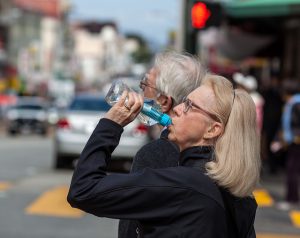Each week, Dr. Mauk shares thoughts relevant to Baby Boomers that are aimed to educate and amuse.
Guest Blog: How You Can Find the Best Senior Care Centers
Finding the right senior care center for your loved one is a daunting task. With so many different types of care centers available, it’s important to understand the differences between them and to research the options in order to determine which one best fits your loved one’s needs. From residential care homes to assisted living facilities, there are a variety of options to consider.
There are also important factors to consider such as the quality of care provided, the cost of care, and the atmosphere of the facility. By taking the time to understand the different types of senior care centers, researching the options, and considering the factors that are important to your loved one, you can make an educated and informed decision that will ensure your loved one is receiving the best care possible. Top class hospitals also have their own senior care network which can be consulted according to one’s need.
Unlocking the Secrets to Finding the Perfect Senior Care Center for Your Loved One
Finding the right senior care center for your loved one is a daunting task. With so many different types of care centers available, it’s important to understand the differences between them and to research the options in order to determine which one best fits your loved one’s needs. From residential care homes to assisted living facilities, there are a variety of options to consider.
There are also important factors to consider such as the quality of care provided, the cost of care, and the atmosphere of the facility. By taking the time to understand the different types of senior care centers, researching the options, and considering the factors that are important to your loved one, you can make an educated and informed decision that will ensure your loved one is receiving the best care possible.
Types of Senior Care Centers
When you begin your search for the perfect senior care center for your loved one, it’s important to understand the different types of care centers available. Each type of care center offers different amenities and services, and each one is designed to meet the needs of a different type of senior.
The first type of care center is a residential care home, which is a residential home or building that provides care services for seniors. Residential care homes typically provide on-site nursing care and assistance with daily activities such as bathing, dressing, and grooming. They also provide social activities and recreational activities, as well as meals and housekeeping.
Another type of care center is an assisted living facility, which is a residential community designed to provide care and assistance with daily activities. Assisted living facilities typically offer a variety of services such as meals, housekeeping, personal care, and social activities. They also provide medical care and supervision, as well as help with mobility and other activities of daily living.
Finally, there are nursing homes, which provide more comprehensive medical care for seniors who are unable to live independently. Nursing homes offer a variety of services such as skilled nursing care, rehabilitation services, social activities, and more.
Factors to Consider When Choosing the Right Care Center
When you’re considering the different types of care centers available, it’s important to take into account the factors that are important to your loved one. It’s important to consider the quality of care provided, the cost of care, and the atmosphere of the facility.
The quality of care is an important factor to consider when choosing a care center. It’s important to make sure that the care center is providing quality care, and that the staff is experienced and knowledgeable. It’s also important to make sure that the care center is following best practices and is compliant with state and federal regulations.
The cost of care is also an important factor to consider. Different care centers have different rates, and it’s important to make sure that the care center you’re considering is affordable for you and your loved one. It’s also important to make sure that the care center is covered by your loved one’s insurance, if applicable.
Finally, the atmosphere of the facility is an important factor to consider. It’s important to make sure that the facility is clean, comfortable, and safe for your loved one. It’s also important to make sure that the staff is friendly and welcoming, and that there are activities and social opportunities available for your loved one.
Exploring Your Options
Once you’ve taken the time to understand the different types of care centers and to consider the factors that are important to your loved one, it’s time to start exploring your options. The best way to do this is to visit the care centers in person and to take a tour. This will give you a good idea of what the care center is like and whether or not it is the right fit for your loved one.
When visiting care centers, it’s important to ask questions and to observe the environment. During your visit, it’s important to ask questions about the quality of care provided, the cost of care, and the atmosphere of the facility. It’s also important to ask about the activities and social opportunities available for your loved one. This will give you a better understanding of what the care center has to offer and whether or not it is the right fit for your loved one.
Quality of Care
The quality of care is an important factor to consider when choosing a care center for your loved one. It’s important to make sure that the care center is providing quality care and that the staff is experienced and knowledgeable. It’s also important to make sure that the care center is following best practices and is compliant with state and federal regulations.
When visiting care centers, it’s important to ask questions about the quality of care provided. You should ask questions about the staff’s experience and qualifications, the types of services offered, and the protocols that are in place to ensure quality care. You should also ask about the availability of medical care and the types of treatments offered.
It’s also important to ask for references from the care center and to speak with other families who have used the care center in the past. This will give you a better understanding of the quality of care provided and whether or not it is the right fit for your loved one.
Cost of Care
The cost of care is another important factor to consider when choosing a care center for your loved one. Different care centers have different rates, and it’s important to make sure that the care center you’re considering is affordable for you and your loved one. It’s also important to make sure that the care center is covered by your loved one’s insurance, if applicable.
When visiting care centers, it’s important to ask questions about the cost of care. You should ask about the fees for services, the availability of financial assistance, and the payment plans that are available. You should also ask about any additional fees that may be associated with the care center.
It’s also important to ask about the availability of discounts or special offers for seniors. Many care centers offer discounts for seniors, so it’s important to ask about these before making a decision.
Atmosphere of the Facility
The atmosphere of the facility is another important factor to consider when choosing a care center for your loved one. It’s important to make sure that the facility is clean, comfortable, and safe for your loved one. It’s also important to make sure that the staff is friendly and welcoming, and that there are activities and social opportunities available for your loved one.
When visiting care centers, it’s important to observe the atmosphere of the facility. You should pay attention to the cleanliness of the facility, the friendliness of the staff, and the availability of activities and social opportunities. You should also take note of the overall atmosphere of the facility and whether or not it is a place that your loved one would be comfortable in.
It’s also important to ask about the security of the facility. You should ask about the safety protocols in place to protect your loved one and to ensure their wellbeing.
Questions to Ask During Your Tour
When visiting care centers, there are a few key questions that you should ask during your tour. These include:
- What services are offered? • What is the quality of care provided? • What is the cost of care? • Are there any discounts or special offers for seniors? • What is the atmosphere of the facility like? • What activities and social opportunities are available? • What is the security of the facility like? • What protocols are in place to ensure quality care?
Asking these questions will help you get a better understanding of the care center and whether or not it is the right fit for your loved one.
What to Look for During Your Visit
When visiting care centers, there are a few key things to look for during your tour. These include:
- Cleanliness: It’s important to make sure that the facility is clean and well-maintained. • Staff: It’s important to make sure that the staff is friendly and welcoming. • Activities: It’s important to make sure that there are activities and social opportunities available for your loved one. • Security: It’s important to make sure that the facility is secure and that safety protocols are in place. • Atmosphere: It’s important to make sure that the atmosphere of the facility is comfortable and welcoming.
It’s also important to take note of anything else that stands out during your visit. This will help you get a better understanding of the care center and whether or not it is the right fit for your loved one.
Making an Educated Decision
Once you’ve taken the time to understand the different types of care centers, to research the options, and to visit the care centers in person, it’s time to make an educated decision. It’s important to consider all of the factors that are important to your loved one, such as the quality of care, the cost of care, and the atmosphere of the facility.
Once you’ve taken all of these factors into consideration, it’s important to take the time to make an informed decision. It’s also important to discuss your decision with other family members and to make sure that everyone is in agreement.
Making an educated decision about the care center for your loved one is an important responsibility, and it’s important to take the time to make sure that you’re making the right decision. By taking the time to understand the different types of care centers, researching the options, and considering the factors that are important to your loved one, you can make an informed decision that will ensure your loved one is receiving the best care possible.
Conclusion
Finding the right senior care center for your loved one is a daunting task. With so many different types of care centers available, it’s important to understand the differences between them and to research the options in order to determine which one best fits your loved one’s needs. By taking the time to understand the different types of senior care centers, researching the options, and considering the factors that are important to your loved one, you can make an educated and informed decision that will ensure your loved one is receiving the best care possible.







